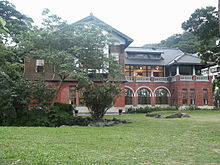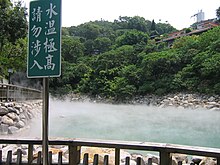Beitou
|
Beitou 北投 區 |
||
 Location of Beitou in Taipei |
||
| State : |
|
|
| Coordinates : | 25 ° 7 ′ N , 121 ° 30 ′ E | |
| Area : | 56.8216 km² | |
| Residents : | 256,424 (Sep 2017) | |
| Population density : | 4,513 inhabitants per km² | |
| Time zone : | UTC + 8 (Chungyuan time) | |
| Telephone code : | (+886) (0) 2 | |
| ISO 3166-2 : | TW-TPE | |
| Community type : | Taipei City District | |
| Structure : | 42 Li (里), 827 Lín (鄰) | |
| Website : | ||
|
|
||
Beitou ( Chinese 北投 區 , Pinyin Běitóu Qū ) is a district of Taipei . The municipality is very mountainous and is famous for its hot springs .
Overview and geography
Beitou is the northernmost borough of Taipei. It borders the Shilin District to the south and east, the Danshui District in New Taipei to the west, and Sanzhi and Jinshan to the north . The northeast of the district is part of Yangmingshan National Park .
Beitou occupies an area of 56.8216 km², which makes it the second largest district in Taipei. In 2017, Beitou had about 256,000 inhabitants.
history
The name 'Beitou' is said to be borrowed from the native languages of Taiwan and means 'witch'. The first contact with Europeans came when the Spanish established several branches in the north of the island of Taiwan in 1629. A few years later the Spanish were ousted by the Dutch. In 1662, Dutch Formosa was conquered by the Chinese general Zheng Chenggong and then became part of the Chinese Empire. After that, Beitou's history ran parallel to the rest of Taiwan's history. During the Japanese rule over Taiwan was Beitou interlocutory 1920 and 1941 a village ( 北投庄 Hokuto-shō ) in the district Shichisei ( 七星郡 ) in the prefecture of Taihoku (Taipei). In 1941 it was promoted to a city ( 北投 街 ). After it was taken over by the Republic of China, it was assigned to Taipei County with the status of a township ( 北投 鎮 , Běitóu Zhèn ). On July 1, 1968, it finally became a district of Taipei City.
Hot Springs
The hot springs were discovered in 1894 by the German sulfur merchant Ouely. In 1896, an Osaka merchant built the first hot spring hotel in the area.
In Beitou there is the Hot Spring Museum ( 北投 溫泉 博物館 , Běitóu Wēnquán Bówùguǎn ), an earlier public bath house from the Japanese era. It was built on June 17, 1913 and was famous at the time for its English country house architecture. The public bath was located on the ground floor, which consists of bricks, and a recreation area on the first floor, made of wood. In 1923, the then Japanese Crown Prince and later Emperor Hirohito visited the bath. After Taiwan was transferred to the Republic of China in 1945, the bathhouse eventually fell into disuse and fell into disrepair. After the building was discovered in 1994 by a group of teachers and students from a primary school in Beitou, it was restored from 1998. Today the museum houses exhibits on the history of the hot springs in Beitou, the theory of hot springs, the history of the Ketagalan (the ancient indigenous people of Taipei) and the discovery of Hokutolite (a type of mineral).
The museum is located in a park in Beitou, through which a river flows from the hot spring. Adjacent to it are several hotels that offer their own baths, as well as a public open-air bath. There is also a wooden municipal library next to the park.
traffic
Beitou is accessible by Taipei Metro (MRT) on the Danshui Red Line. The railway stations Guandu, Zhongyi, Fuxinggang, Beitou, Qiyan, Qili'an, Shipai and Mingde are located directly on this line. A line branches off from Beitou Station to Xinbeitou Station, which makes the hot springs accessible.
The provincial roads PH 2a from Jinshan to Taipei and the PH 2b from Taipei to Danshui also run through Beitou . The area can also be reached by many bus routes.
Historically, a road between Dadaocheng and Beitou was opened in 1897 . In 1901 the Beitou Railway was inaugurated and the Beitou station built. In 1916, a branch line from Beitou Station to Xinbeitou (New Beitou) Station was built in order to better reach the hot springs from Taipei. With the establishment of the MRT, the original railroad became a line of the subway.
gallery
Web links
- Official website of Beitou
- Taipei Hot Springs Association (English and Chinese)
Individual evidence
- ↑ a b c About Beitou District. Taipei City Council, accessed November 16, 2017 .
- ↑ Taipei Hot Springs Association: The Beitou Hot Spring Museum ( Memento of the original from October 15, 2013 in the Internet Archive ) Info: The archive link was inserted automatically and has not yet been checked. Please check the original and archive link according to the instructions and then remove this notice. . Retrieved November 26, 2012.








